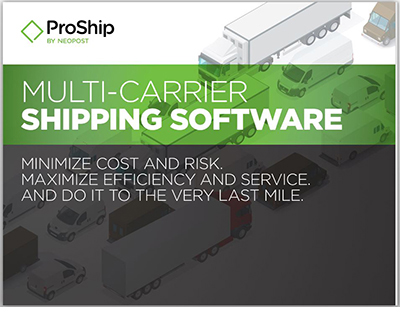21 Requirements to Consider For a New Multi-Carrier Shipping & Manifesting System
Does your current shipping solution cut it?
Written by Brian Barry, F. Curtis Barry & Company
Input and contribution by ProShip, Inc.
Experts expect U.S. parcel volume to increase from 21.2 billion in 2022 to 28 billion by 2028. That is more than a 32% increase over 6 years, equating to about a 5% increase year over year (Source: Pitney Bowes, March 2023). At the same time, the last mile of many of those parcel deliveries will account for 53% of total shipping costs, on average.
For most omnichannel businesses, the cost of shipping now exceeds the sum of all other fulfillment costs. This includes direct and indirect payroll of team members, benefits, facilities and utilities, packing supplies, and more. Businesses need every advantage they can get to hopefully evaluate, reduce or control the rate of shipping expense increases.
Earlier generations of shipping and manifesting systems didn’t have much functionality other than weighing packages and generating labels and manifests. Today’s shipping systems have great functionalities that help with controlling current and future shipping costs. However, some businesses have not yet explored these cost effective functionalities.

New generation systems have rate shopping, the preparation of international documentation, track and trace, and analysis of shipping data. They also include enterprise-wide control from multi-locations including DCs, stores and suppliers. Many of these features were built with the customer experience in mind. The goal is to customize your abilities to best suit your customers’ needs and provide the ultimate customer satisfaction.
Features and Functional Software Requirements
As you consider the many shipping and manifesting software vendor offerings, here are 21 considerations and questions for features, requirements and support. When looking at these features, always keep your customers top of mind. Which functionality do you need to keep your customers coming back?
Considerations for Shipping
- What are the throughput requirements (packages per hour and day) for your distribution network for all locations? Take into account all types of documents and packages from all locations including stores, warehouses and drop shipments from manufacturers and suppliers.
- How can best-way shipping options benefit your customers and reduce costs based on shipping rates, service levels and delivery time?
- What real-time business rules for shipping and manifesting can you, or should you, implement?
- Carrier compliance is extremely important. Does the solution support multiple carriers? Which solutions provide immediate support for rate changes, updates and creation of all labels and documents including hazmat, manifests and international?
- Does the solution have address validation to reduce carrier charges for undeliverable addresses and residential deliveries erroneously classified as commercial? If not, how will you support this need?
- How fast does the system rate shop and generate labels?
- What processes can be eliminated from your existing shipping and manifesting environment to make it less manual, more efficient and speed up the packages shipped per hour?
- Does the solution support multi-carton orders that require different carriers and service levels (e.g. LTL and expedited package on one order)?
International Shipping
- Does the solution produce customs-related documents including certificate of origin, commercial invoices and shipper export declaration? Is it certified for ACE (AES) Direct Filings?
- Does the solution handle both shipping to and shipping from other countries around the world? Can it support international carriers?
Scalability
- As you grow, can the solution scale with you? Can it scale from one workstation to an enterprise-wide solution? What functionality can be added to the installed system that will help your company grow and change?
- Could it support centralized manifesting, versus doing it at each pack station? Could it be automated to eliminate human error from the manifesting process?
Customer Service Related
- Does the solution provide complete track and trace ability both internally and externally? Does it allow complete order visibility to the customer and answer questions about package status and destination?
Information Technology
- How intuitive is the user interface (i.e. ease of use)?
- What integration requirements are there to your Order Management Solution (OMS), ERP and Warehouse Management Systems (WMS)? Does the solution have these integrations?
- What technology do you need to accommodate for in terms of bar code reading, weighing scales and automation?
Vendor Support
- Consider the implementation expertise of the software solution providers. How turnkey will implementation of this system be? What responsibilities will you have?
- How do software updates work? Are there automated updates, such as new system releases and features?
- What is the overall support process? Does the solution provide 24/7 support?
Data Analysis and Reporting
- What reports are available in terms of analytics and audit? What other data is accessible?
- Is there a dashboard of key shipping metrics?
Moving Forward
Like any other systems project, document your user requirements. Then develop a Request for Proposal (RFP), sending it to a short list of qualified vendors you believe can meet your requirements. Analyze the vendor responses and invite the two or three best candidates to go through the demonstration phase and deep dive of the features, benefits and pricing. Select the solution that you believe will cultivate the best value for you and your customers.
Selecting a highly functional shipping and manifesting system may be one of the very best ways to deal with the continual escalation of shipping costs.
When it comes to the shipping world, ProShip is the value player.
Get in the know.
Note: F. Curtis Barry & Company does not endorse any systems vendors. In our client studies we believe in objective, multi-vendor bidding process. We thank ProShip, an enterprise system vendor, for their input to this blog. ProShip offers the throughput, carrier compliance and support required by large-volume, enterprise shipping operations, integrating with regional, national and international parcel carriers.
Original post: https://www.fcbco.com/blog/requirements-new-omnich...
Featured on MCM: http://multichannelmerchant.com/blog/20-things-con...

